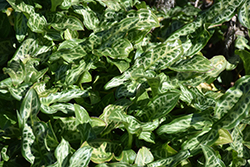It's all about ...
plants

White Winter Arum
Arum italicum 'White Winter'
Height: 12 inches
Spread: 12 inches
Sunlight:
![]()
![]()
Hardiness Zone: 6b
Other Names: Winter White Arum, Cuckoo Pint, Lords-and-Ladies
Description:
Glossy dark green arrowhead foliage with striking bright white mottling from fall into spring; orange-red berries appear during summer dormancy; the leaves and berries are great for flower arrangements; a perfect shade plant
Ornamental Features
White Winter Arum is primarily grown for its highly ornamental fruit. It features an abundance of magnificent orange berries with red overtones from late summer to mid fall. Its attractive large glossy pointy leaves remain dark green in colour with distinctive creamy white veins throughout the season. It features subtle lightly-scented bracted white hooded flowers with white sheaths rising above the foliage in late spring.
Landscape Attributes
White Winter Arum is a dense herbaceous perennial with an upright spreading habit of growth. Its relatively coarse texture can be used to stand it apart from other garden plants with finer foliage.
This plant will require occasional maintenance and upkeep, and is best cleaned up in early spring before it resumes active growth for the season. Deer don't particularly care for this plant and will usually leave it alone in favor of tastier treats. Gardeners should be aware of the following characteristic(s) that may warrant special consideration;
- Spreading
White Winter Arum is recommended for the following landscape applications;
- Border Edging
- General Garden Use
- Groundcover
- Naturalizing And Woodland Gardens
- Container Planting
Planting & Growing
White Winter Arum will grow to be about 12 inches tall at maturity, with a spread of 12 inches. Its foliage tends to remain dense right to the ground, not requiring facer plants in front. It grows at a medium rate, and under ideal conditions can be expected to live for approximately 10 years. As an herbaceous perennial, this plant will usually die back to the crown each winter, and will regrow from the base each spring. Be careful not to disturb the crown in late winter when it may not be readily seen! As this plant tends to go dormant in summer, it is best interplanted with late-season bloomers to hide the dying foliage.
This plant does best in partial shade to shade. It prefers to grow in average to moist conditions, and shouldn't be allowed to dry out. It is not particular as to soil type or pH. It is somewhat tolerant of urban pollution. This is a selected variety of a species not originally from North America, and parts of it are known to be toxic to humans and animals, so care should be exercised in planting it around children and pets. It can be propagated by division; however, as a cultivated variety, be aware that it may be subject to certain restrictions or prohibitions on propagation.
White Winter Arum is a fine choice for the garden, but it is also a good selection for planting in outdoor pots and containers. It is often used as a 'filler' in the 'spiller-thriller-filler' container combination, providing a mass of flowers and foliage against which the larger thriller plants stand out. Note that when growing plants in outdoor containers and baskets, they may require more frequent waterings than they would in the yard or garden. Be aware that in our climate, most plants cannot be expected to survive the winter if left in containers outdoors, and this plant is no exception. Contact our experts for more information on how to protect it over the winter months.
This plant is not reliably hardy in our region, and certain restrictions may apply; contact the store for more information.
